1996 eruption of Gjálp
Gjálp (Icelandic pronunciation: [ˈcaul̥p]) is a hyaloclastite ridge (tindar) in Iceland under the Vatnajökull glacier shield. It originated in an eruption series in 1996 and is probably part of the Grímsvötn volcanic system,[4][5] though not all the scientists involved are of this opinion.
| 1996 eruption of Gjálp | |
|---|---|
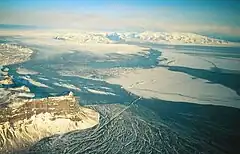 Gjálp eruption: Jökulhlaup 1996 over Skeiðarársandur, the piedmont glacier Skeiðarárjökull and Öræfajökull in the background | |
| Volcano | Gjálp |
| Start date | 30 September 1996[1] |
| End date | 13 October 1996[1] |
| Type | Subglacial fissure eruption |
| Location | Western Vatnajökull 64°32′00″N 17°25′00″W[2] |
| VEI | 3[3] |
| Impact | Jökulhlaup over Skeiðarársandur, Hringvegur partially destroyed |
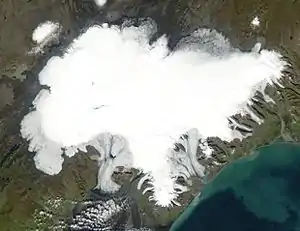
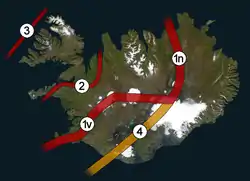
Importance
The eruption was of imminent importance, because it was for the first time that a subglacial eruption under a thick ice cover as well as the connected jökulhlaup could be observed and analyzed by modern technique.[6][7]
Geography
Eruption location
The subglacial eruption fissure is to be found in the northwest corner of Vatnajökull ice cap more or less half way between the central volcanoes Bárðarbunga and Grímsvötn.[1]
Vatnajökull ice cap
The Vatnajökull glacier which covered the location at time of eruption had a thickness of 500–600 m. In other places the glacier shield can have thicknesses of up to 900 m. Vatnajökull covered an area of 8.200 km2 in 1996,[8] but it is retreating and measured just 8.100 km2 in 2007.[9] The glacier is temperate, lies in lower elevations and is therefore sensible to climatic changes. As a consequence it has been advancing and retreating since the Weichselian glaciation. Its last advance took place during the so called Little Ice Age from the 13th to the end of the 19th century and since then it is retreating.[9]
Parts of two volcanic zones of Iceland are placed under Vatnajökull, ie. the very active East Volcanic Zone (connected to rifting at the divergent plate boundary in Iceland[9]), responsible for the highest number of eruptions after deglaciation[10] and with the mantle plume probably under Bárðarbunga, ie. under Vatnajökull.[11] "More than 80 eruptions occurred during the last 800 years in Vatnajökull."[12] There is also the much less active Öraefi Volcanic Belt, a flank zone mostly under the eastern part of Vatnajökull.[9][13] It is thought that due to climate change, Vatnajökull has lost about 10% of its mass since the end of the 19th century. Measurements showed an accentuated and even accelerating rate of glacio-isostatic uplift.[11] This could lead to increased magma production (so called decompression melt production), because the "pot lid" formed by the glaciers and their weight will be absent in the future, and eruption frequency could increase as a consequence.[14]
The region of the Gjálp fissures is part of this active East Volcanic Zone under Vatnajökull.
Geology
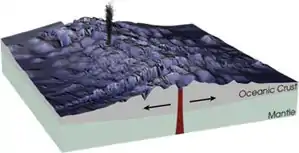
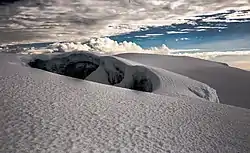
07(js).jpg.webp)
The Gjálp eruption formed in about two weeks a subglacial hyaloclastite ridge, also called tindar by some geologists, in a zone of known former eruptions.
Precursors and possible connection between volcanic systems
Some heavy earthquakes (M5+) had taken place in the central volcano Bárðarbunga before and proved to be precursors of the eruptive events. New seismological studies (2019) see a parallel to the 2014–2015 eruptions and to the caldera drop in Bárðarbunga central volcano and postulate a similar magma migration to the eruption site though on a smaller scale. This could mean that the volcano is part of the fissure system of Bárðarbunga, not Grímsvötn.[15]
Another possibility is that Bárðarbunga magma entered in a smaller portion the magmatic system of Grímsvötn and started the eruption by this intrusion. Bárðarbunga is known for such tendencies, her magma mingled with Torfajökull magma at least three times in the past which resulted in bimodal eruptions, eg. of the Veiðivötn and at Landmannalaugar by the end of the 15th century.[16]
Formation of the tindar volcano
The Gjálp eruption took place at a some kilometers long known fissure under 550–700 m of glacier ice within Vatnajökull. The eruption in October 1996 could push through this ice in about 30 hours[4] and took place from 30 September to 13 October 1996. The eruption fissure had a length of 6–7 km.[1]
The location is some kilometers to the north of Grímsvötn caldera.[4]
In the beginning, a 2–4 km long N–S trending depression was formed above the fissure, with time three ice cauldrons were built at each end and in the middle,[1] but the eruption concentrated later on one of them where a 200–300 m wide crater came to light. After some time, an open ice canyon was built above the fissure. It had a length of about 3,5 km and was up to 500 m in width.[4]
The meltwater drained first through the ice canyon and then disappeared into subglacial channels and run from there to the subglacial caldera lake of Grímsvötn.[4] The subglacial channels were easily recognized, because continuous melting caused by the hot water from the eruption site initiated the formation of depressions on the ice surface. And so the scientists followed the melting path down to Grímsvötn caldera.[1]
Though the eruption was mostly explosive, the ash was not expelled far from the vents, but fell back into the canyon. The quantity of eruption products stayed more or less the same the whole time which was explained by ice flow into the crater.[4]
During the two weeks of eruption, volcanic activity thawed no less than 3 km3 of ice, and this continued to a lesser extent for some time after the end of the eruption.[4]
The newly formed tindar disappeared again completely under the glacier ice about 1 year later.[4]
Eruption products
The eruptive products consisted of basaltic andesite which surprised the scientists as these more evolved rocks are neither typical for Bárðarbunga nor for Grímsvötn, both more connected to basaltic volcanism. Some scientists thought that Gjálp could be an independent volcano.[8]
Jökulhlaup in 1996
.jpg.webp)
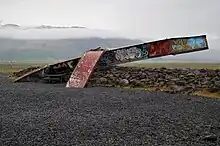
In the beginning, scientists presumed that the eruption would be followed immediately by a big jökulhlaup (sort of a meltwater tsunami including large blocks of ice and a high quantity of sediment). But it took some time to fill the subglacial lake of Grímsvötn in such a manner that the ice wall holding it back would break.[4]
Not before some weeks had passed after the eruption was terminated, the expected jökulhlaup took place from 4 to 7 November 1996.[8] The meltwater streamed mostly in subglacial channels and in the end under the outlet glacier Skeiðarárjökull. There, to everybody's surprise, the water masses streamed in such a quantity that the whole glacier was lifted up.[17][18]
In the end, the water sprang up from under the glacier edge and the flood covered most of Skeiðarársandur glacial outwash plain destroying on its way big parts of the main road Hringvegur including two bridges and some communication installations. Luckily, the road had been closed before so that nobody was injured.
The volume of meltwater produced by this eruption was around 4 km3.[19] Over the sandur streamed up to 50–60.000 m3/sec.[4] The first estimates had been somewhat lower.[8]
Former eruption in 1938
At more or less the same place another eruption had taken place in the 1930s. It had also caused a jökulhlaup, but at the time, science could not yet analyze the events.
This eruption stayed subglacial.[4]
See also
Further reading
References
- Helgi Björnsson, etal: Glacier-volcano interactions deduced by SAR-inferometry. Journal of Geology. Vol. 47, no. 156 (2001). Retrieved 8 August 2020.
- A. Jarosch et al.: Progressive cooling of the hyaloclastite ridge at Gjálp, Iceland, 1996–2005. Journal of Volcanology and Geothermal Research 170 (2008) 218–229
- Global Volcanism Program.
- Snæbjörn Guðmundsson: Vegavísir um jarðfræði Íslands. Reykjavík 2015, p. 280-281
- See also GVP: Grimsvotn. Eruptive history. Retrieved 29 August 2020.
- Magnús T. Gudmundsson, Freysteinn Sigmundsson, ·Helgi Björnsson, Thordís Högnadóttir: The 1996 eruption at Gjálp, Vatnajkull ice cap, Iceland: efficiency of heat transfer, ice deformation and subglacial water pressure. Bull Volcanol. (2004) 66:46–65 DOI 10.1007/s00445-003-0295-9
- See also: Hugh Tuffen, D.W. McGarvie, etal.: Will subglacial rhyolite eruptions be explosive or intrusive? Some insights from analytical models. Annals of Glaciology, in press. Lancaster University. (2006) Retrieved 30 August 2020.
- P. Einarsson, Bryndis Brandsdottir, Magnus Tumi Gudmundsson, Helgi Bjornsson, Karl Gronvold and Freysteinn Sigmundsson: Center of Icelandic Hotspot experiences Volcanic Unrest. Eos, Vol. 78, No. 35, September 2, 1997. Retrieved 29 August 2020.
- C. Pagli, etal.: Glacio-isostatic deformation around the Vatnajökull ice cap, Iceland, induced by recent climate warming: GPS observations and finit element modeling. JOURNAL OF GEOPHYSICAL RESEARCH, VOL. 112, B08405, doi:10.1029/2006JB004421, 2007 Retrieved 8 August 2020.
- Thorvaldur Thordarson, Ármann Höskuldsson: Postglacial volcanism in Iceland. Jökull No. 58 (2008).
- Hildur María Friðriksdóttir: Landris á Vatnajökulssvæðinu metið með GPS landmælingum. BS ritgerð. Jarðvísindadeild Háskóli Íslands. Leiðbeinendur Sigrún Hreinsdóttir, Erik Sturkell. (2017)
- Helgi Björnsson: Subglacial lakes and jökulhlaups in Iceland. Global and Planetary Change 35 (2002) 255–271 Retrieved 31 August 2020.
- See also: Helgi Björnsson, Páll Einarsson: Volcanoes beneath Vatnajökull, Iceland. Evidence from radio echo sounding, earthquakes and jökulhlaups. Jökull no. 40, 1990 Retrieved 8 August 2020.
- See eg.: P. Schmidt, etal.: Effects of present-day deglaciation in Iceland on mantle melt production rates. JOURNAL OF GEOPHYSICAL RESEARCH: SOLID EARTH, VOL. 118, 3366–3379, doi:10.1002/jgrb.50273, 2013 (PDF) Retrieved 4 September 2020.
- K. I. KONSTANTINOU, etal.: Reappraisal of Seismicity Recorded During the 1996 Gjálp Eruption, Iceland, in Light of the 2014–2015 Bárðarbunga–Holuhraun Lateral Dike Intrusion. Pure Appl. Geophys. https://doi.org/10.1007/s00024-019-02387-x
- See eg.: G.F. Zellmer, etal.: On the recent bimodal magmatic processes and their rates in theTorfajökull–Veidivötn area, Iceland. Earth and Planetary Science Letters 269 (2008) 387–397.
- Tomas Jóhannesson: Propagation of a subglacial flood wave during the initiation of a jôkulhlaup. Hydrological Sciences-Journal-des Sciences Hydrologiques. 47(3 ) June 2002 Retrieved 8 August 2020.
- See also: Helgi Björnsson: Understanding jökulhlaups: from tale to theory. Journal of Glaciology, Vol. 56, No. 200, 2010.] Retrieved 8 August 2020.
- M.T. Gudmundsson, G. Larsen, Á. Höskuldsson and Á.G. Gylfason: Volcanic hazards in Iceland. Jökull no. 58 (2008) (PDF) Retrieved 8 August 2020.